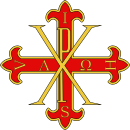| Sacred Military Constantinian Order of Saint George | |
|---|---|
 Cross of the order | |
| Type | Dynastic order |
| Founded | c. 1545 |
| Royal house | |
| Religious affiliation | Catholic |
| Seat | Santa Croce in Via Flaminia, Rome |
| Ribbon | Light blue |
| Motto | In hoc signo vinces |
| Founder | Constantine the Great (legendary) Andrea Angelo Flavio Comneno (actual) |
| Grand Master | Disputed: Prince Pedro, Duke of Calabria Prince Carlo, Duke of Castro Prince Carlos, Duke of Parma |
| Grades | House of Bourbon-Two Sicilies: See all House of Bourbon-Parma: Senator Grand Cross with Collar Senator Grand Cross Knight/Dame Commander Knight/Dame 1st class Knight/Dame 2nd class |
| Precedence | |
| Next (higher) | House of Bourbon-Two Sicilies: Royal Order of Saint Januarius House of Bourbon-Parma: None (highest) |
| Next (lower) | House of Bourbon-Two Sicilies: Royal Order of Saint Ferdinand and of Merit House of Bourbon-Parma: Ducal Royal Order of Saint Louis |
Ribbon of the order | |
The Sacred Military Constantinian Order of Saint George (Italian: Sacro Militare Ordine Costantiniano di San Giorgio; Spanish: Sagrada Orden Militar Constantiniana de San Jorge), also historically referred to as the Imperial Constantinian Order of Saint George[1] and the Order of the Constantinian Angelic Knights of Saint George,[2] is a dynastic order of knighthood of the House of Bourbon-Two Sicilies.[3] Currently, the grand magistry of the order is disputed among the two claimants to the headship of the formerly reigning House of Bourbon-Two Sicilies as heirs of the House of Farnese, namely Prince Pedro and Prince Carlo. The order was one of the rare orders confirmed as a religious-military order in the papal bull Militantis Ecclesiae in 1718, owing to a notable success in liberating Christians in the Peloponnese. Together with the Sovereign Military Order of Malta, it is one of a small number of Catholic orders that still have this status today.[4] It is not an order of chivalry under the patronage of the Holy See, but its membership is restricted to practising Catholics.[5][6]
Although the order is alleged to have been founded in its original form by Constantine the Great in Antiquity and then restored under later Byzantine emperors, the actual origin of the order can be traced to the 16th century, when it was founded by an Albanian noble family named Angelo Flavio Comneno. Though this family, extinct in 1698, claimed to be connected to the Byzantine Komnenos and Angelos dynasties, such a direct familial connection cannot be proven; the family does, however, descend from a marriage into the Arianiti family that has several descents from past Byzantine imperial families. Chivalric orders were completely unknown in the Byzantine world, so much of the alleged history of the order was invented much later. Outside the generally recognized line of grand masters from its origin in the 16th century to the present day, there have been many people claiming to be grand masters who have been forgers and title-seekers hoping to gain support for invented lines of descent from ancient and medieval nobility.
- ^ Nicol, Donald M. (2002-05-09). The Immortal Emperor: The Life and Legend of Constantine Palaiologos, Last Emperor of the Romans. Cambridge University Press. p. 120. ISBN 978-0-521-89409-8.
- ^ The Institution, Laws and Ceremonies of the Most Noble Order of the Garter Collected and Digested Into One Body Etc. J. Macock. 1672. p. 63.
- ^ "StackPath". 16 October 2012.
- ^ Sainty, Guy Stair (2018-12-01). The Constantinian Order of Saint George: and the Angeli, Farnese and Bourbon families which governed it. Boletín Oficial del Estado. p. 12. ISBN 978-84-340-2506-6.
- ^ "Clarification of the Secretariat of State of the Holy See on the Equestrian Orders" (Press release). Secretariat of State of the Holy See. 17 October 2012. Retrieved 21 July 2023.
- ^ Adernò, Fabio (22 October 2012). "La Santa Sede e gli Ordini Cavallereschi: doverosi chiarimenti (Seconda parte)". Zenit (in Italian). Retrieved 22 August 2016.